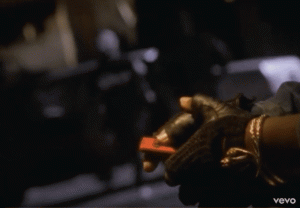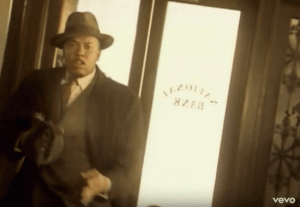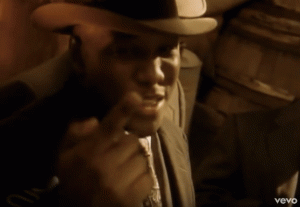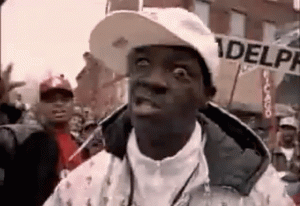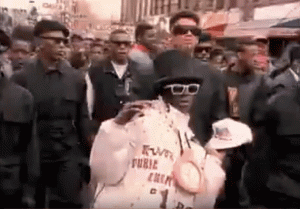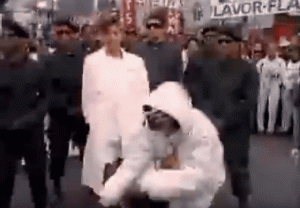APPETITE FOR DESTRUCTION
N.W.A. and Public Enemy were known for their politically charged music that critiqued establishments of power and expressed frustration towards the climate of American society. Both groups deliberately aimed to shed light on the hardships minority groups faced, and they were undeniably successful. The type of rap that emerged from early groups circa the ‘90s served as a form of resistance by offering a platform for alienated and oppressed groups to voice their struggles (Beighey 134). Additionally, rap music at this time often demanded and justified the legitimacy and of black identity in an attempt to push for racial equality (Beighey 134). Despite the positive impact gangsta rap had on raising awareness of pertinent issues in black communities, identifiers of the genre ultimately proved problematic. The music and videos of N.W.A. and Public Enemy illustrate, in different ways, the employment of controversial personas that paralleled minstrel show archetypes. For example, gangsta rapper frequently told stories of excessive violence, or in other words savagery, which evokes memories of tales used to defend slavery in the 1800s (LaGrone 122).
In “Appetite for Destruction” by N.W.A., the group’s behavior showcases the violent tendency that could easily be associated with the savage archetype. In addition, their aggressive and politically vocal lyrics could be associated with the militant archetype. Firstly, the visuals explicitly portray this. The music video depicts the members of N.W.A. as old school gangsters, drinking, gambling, and flirting with women. The crew proceeds to rob a bank at gunpoint, racking up several casualties along the way. As the group runs off with their earnings, the vintage aesthetic abruptly switches to what looks like the present (90s). On and off screen diegetic sounds like gunshots, cars screeching, and police sirens add to the chaotic and violent environment the group identifies with.
Each member of N.W.A. has a similar delivery of their verse. The aggressive, angry, and blunt style of rapping has blatant similarities to the militant archetype that emerged during the Civil Rights Movement. Overall, the video has clear overarching themes of crime and violence, but the lyrics bring it to another level. Every verse of the song includes lines about guns, murder, and physical violence. While certain lyrics exemplify one of early raps purposes of demanding legitimacy of black identity, others comment on policy brutality. However, the majority of the lyrics in this particular song focus on violence inflicted by the group members themselves, for example: “I shoot down a million n***** and shoot one more,” “I smoke any fools tryna cause some static,” and “I got a .38 hidden up the sleeve.” The style of the lyrics are quite consistent with N.W.A.’s other songs. The explicit nature of the verses adds to the shock factor that N.W.A.’s image is all about, which is also seen and heard in “Straight Outta Compton” and “Fuck Tha Police.” Though the group’s attention grabbing sound was very successful, gangsta rap was often criticized for being too vulgar.
Critics of gangsta rap specifically named similarities between gangsta rappers and minstrel characters to condemn the politically and racially charged music. For example, Dr. C. Delores Tucker of the National Political Congress of Black Women called N.W.A. the “Amos ’n’ Andy” of the 1990s, while a Billboard claimed that “what white folks have always believed about black men is just what the works of Ice Cube, N.W.A. and other gangsta rappers confirms today” (Taylor 229). Despite the claims of these concerned critics, as well as the negative impact that perpetuating harmful stereotypes can clearly have, groups such as N.W.A. were able to bring attention to injustices that plagued black communities, demand legitimacy for minority groups who felt alienated by American society, and empower their listeners.
FIGHT THE POWER
In contrast, the musical and visual choices in Public Enemy’s “Fight The Power” are reminiscent of several minstrel archetypes, including the militant man, the Sambo and even Zip Coon. Lyrically, the song is a call to action directed towards African Americans to demand equality and combat racism. Public Enemy speaks to an assumably black audience, encouraging them to take pride in being black and to “fight the powers” that oppress their rights. The song takes a firm political stance, mirroring the militant archetype that was adapted shortly after the Civil Rights Movement. Generally, Public Enemy combined heavy, severe sounding production techniques and Chuck D’s lower vocal register to give a clear political feel to their music (Taylor 229). To reiterate the political nature in “Fight The Power” specifically, the video incorporates diegetic sounds such as cheering coming from the protest-like crowd, matching the sentiment of the lyrics. With lyrics such as “I’m black and I’m proud,” “What we need is awareness, we can’t get careless,” and “Now that you’ve realized the pride’s arrived, we got to pump the stuff to make us tough,” it is clear that Chuck D’s verses are meant to inspire the black population. In this video, Chuck D represents the vocal, political, and aggressive character that was born from the Civil Rights Movement. However, Flava Flav’s persona in juxtaposition to the political backdrop adds an entirely new layer to the song’s overarching narrative.
Though the music video visually supports the lyrical themes of black pride by recreating the March on Washington in a way that alludes to a sense of unity, Flava Flav’s behavior is excessively animated throughout the video. His facial expressions and dance moves are exaggerated, especially in comparison to Chuck D and the extras in the video. As a result, Flava Flav’s performance is reminiscent of the Sambo character, whose inherently racist connotations contradict the lyrical content. Moreover, Flava Flav flashes his jewelry to the camera several times and is wearing a particularly eye-catching outfit. Due to his boasting behavior, one could draw parallels to the materialistic nature of minstrelsy’s Zip Coon character.
In a broader context, Flava Flav’s over-the-top outfit, behavior, and exclamations could be viewed as a strategic decoy. Flava Flav shamelessly embraces the buffoon factor of minstrel characters, but not without a prerogative. Inherently in its title, “Fight The Power” is a song of resistance. With such imposingly serious lyrics, comic relief in Public Enemy’s performances of their politically charged songs was essential in appeasing any potential backlash from white audiences (Taylor 228). However, in a slightly more problematic application, the use of minstrel buffoonery and flashy outfits turns Flava Flav himself into a spectacle. Though some argue that Public Enemy concerts and performances would have been significantly less palatable if Chuck D.’s intense and serious demeanor were the focus, it is not without consequences that Flava Flav’s character guaranteed a show (Taylor 229).
This possible fear of, and essentially catering to, white fragility arguably lessened the intensity and potential impact of Public Enemy’s message in “Fight The Power.” But, given the social climate during the rise of gangsta rap, this may have been a limitation with a price that Public Enemy was willing to pay. With a more mild image, the group had the potential to reach larger audiences, ultimately sharing a positive message of black empowerment to more people. In a way, positioning Flava Flav alongside the song’s Black Power rhetoric made his buffoonery credible, dangerous, and draw attention to the historic racism that the group was reacting to (Taylor 229). While effective in some ways, Flava Flav’s peculiar performance still perpetuated negative stereotypes surrounding black Americans, as his outlandish persona was not presented as an blatant critique of minstrel history to any causal viewer
In both N.W.A. and Public Enemy’s music videos, the allusions to minstrel archetypes highlight the choices that both groups had to make as black artists maneuvering a white-dominated mainstream society. Whether it was strategic or not, both group’s conformation to minstrel-inspired ideology exposes American society’s long history of exploiting of black bodies for white entertainment. In the midst of backlash surrounding the violent imagery evoked by gangsta rap, even Dr. Dre of N.W.A. described his work with the group as “pure entertainment” (LaGrone 121). Despite the fact that much of the content of music by N.W.A. and Public Enemy was specific to issues affecting black communities, statistics from 1991 show that gangsta rap’s largest market was white suburbia (LaGrone 120). It is possible that the adoption of violent or overly animated personas resulted in a performance that appealed to white audiences by confirming some of the stereotypes stemming from minstrel ideology in regards to African Americans.
In short, the influence of minstrel archetypes in early rap music was both effective and problematic. While N.W.A. and Public enemy evoked this imagery in different ways to spread their messages on a larger scale, gangsta rap critics called upon comparisons to minstrel archetypes to critique and discourage early rap groups from continuing to make politically controversial music. Nearly 30 years later, Childish Gambino has flipped the script, using minstrel imagery to frankly critique society instead.
